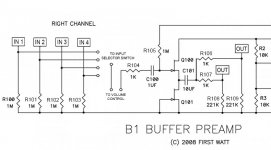Aah, those are the input selectors, cheers!
BTW, do you know how to add a second output? I read it was a matter of adding another R104/R204 but didn't understand how.
Thanks for the BF862 tip. i have been looking at the NOS transistors sold on ebay by UK sellers and the only ones I could find were 2N5458, 2N5459 and 2N3823. I didn't specifically look for BF862 though.
BTW, do you know how to add a second output? I read it was a matter of adding another R104/R204 but didn't understand how.
Thanks for the BF862 tip. i have been looking at the NOS transistors sold on ebay by UK sellers and the only ones I could find were 2N5458, 2N5459 and 2N3823. I didn't specifically look for BF862 though.
I've almost finished building the buffer, just waiting on a couple more components to arrive. Transistors, I have acquired two sets of pukka Fairchild ones, a set of BF256B and a set of 2N5485.
Any preference to which type I use in this buffer?
Any preference to which type I use in this buffer?
Neither. You need characteristics closer to the 2SK170 to get acceptable results. Note its very low noise figure too. BF862 is (was) a safe bet substitute as advised earlier - provided you realise that it's an SMD part and you can safely mount the tiny thing. Since almost all TO92 JFETs have been discontinued and other remaining desirable NOS audio parts have also dried up, genuine NOS parts are worse than expensive. However, the forum shop has the real equivalent LSK170 parts in TO92 form - just not at giveaway prices.
If you see 2SK170 selling cheaply, it's for certain rebadged junk, an unsuitable grade version or simply a poor generic copy that whilst probably emulating basic characteristics, fails to deliver quality audio as expected. There are 2 grades shown on the datasheet and usually, Firstwatt designs specify the higher Idss BL type. In any case, since this is the general Solid State Amplifier forum, I would be asking for advice or offers for suitable parts sources in the Passlabs forum, where there is a better chance of up-to-date DIY advice and experience to draw on. HTTP 301 This page has been moved
Using FAKEFETs or substituting whatever types of JFET you can find isn't going to end well but if you prefer gambling with likely fakes, you'll need to measure and compare the prime characteristics with the real thing, preferably using an instrument like a curve tracer. Something like a Peak-Atlas DCA75 with its curve tracing software is entry level for that, if you're only concerned with small signal components. It also makes a great learning tool for understanding semis generally 😉
If you see 2SK170 selling cheaply, it's for certain rebadged junk, an unsuitable grade version or simply a poor generic copy that whilst probably emulating basic characteristics, fails to deliver quality audio as expected. There are 2 grades shown on the datasheet and usually, Firstwatt designs specify the higher Idss BL type. In any case, since this is the general Solid State Amplifier forum, I would be asking for advice or offers for suitable parts sources in the Passlabs forum, where there is a better chance of up-to-date DIY advice and experience to draw on. HTTP 301 This page has been moved
All of the transistors are N channel JFETs. The stock parts are 2SK170’s, LSK170’s or 2SK370’s, and you can use substitutes having Idss between 5 and 10 milli-Amps and transconductance numbers from 5 to 30 milliSiemens
Using FAKEFETs or substituting whatever types of JFET you can find isn't going to end well but if you prefer gambling with likely fakes, you'll need to measure and compare the prime characteristics with the real thing, preferably using an instrument like a curve tracer. Something like a Peak-Atlas DCA75 with its curve tracing software is entry level for that, if you're only concerned with small signal components. It also makes a great learning tool for understanding semis generally 😉
Thanks Ian, that's very helpful. I did buy a set of BF862 but didn't realise just how iny they are and lost three, can't imagine soldering the things.
I'll see what the shop has to offer.
I'll see what the shop has to offer.
- Status
- Not open for further replies.

